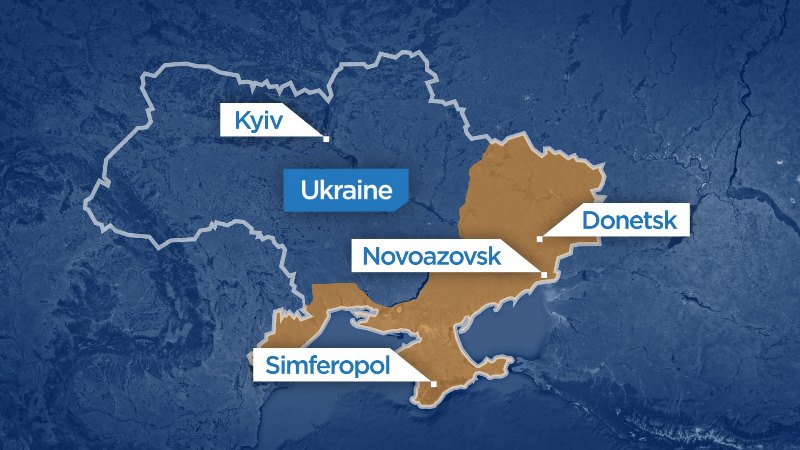Watch above: Russia denies it, but the evidence of an invasion of Ukraine is becoming overwhelming. Stuart Greer reports.

The situation in Ukraine is once again in a perilous position, with President Petro Poroshenko saying Russian forces have invaded the country’s troubled East.
The “full-scale invasion,” as Petroshenko called it, prompted an emergency meeting of the UN Security Council Thursday afternoon and condemnation from Canada, the U.S. and European leaders.
Poroshenko’s comment came after two columns of Russian tanks and military vehicle reportedly crossed into the country on Thursday and Grad missiles were fired at a border post.
In the past month alone, the number of people killed in the conflict between the Ukrainian government and separatist groups, aligned with and supported by Russia, has risen sharply. So, too, has the number of Russians getting involved in the conflict.
Global News takes a look at the numbers and geography of the current state of the crisis in Ukraine.
At least 2,249 — Fighting in the east has killed at least that many people in eastern Ukraine since April. That tally does not include the 298 victims of Malaysia Airlines Flight MH17, which was shot down on July 17 by artillery fired from the separatist-held territory of Donetsk.
But the number of people killed —including civilians, separatist fighters and Ukrainian troops — has doubled in just the past month. According to the UN Office of the High Commissioner for Human Rights (UNOCHR), the death toll on July 26 was at least 1,129. UNOCHR said, at the time, that number was based on “conservative estimates.”
Map: Areas of Ukraine where there has been anti-government or pro-Russia separatist movements since March
1,000+ — NATO said Thursday “well over 1,000 Russian troops” supporting separatist fighters in eastern Ukraine…
20,000 —… But, NATO said there’s at least 20,000 more soldiers assembled on the other side of the Russia-Ukraine border.
Map: NATO released satellite imagery Thursday that it said showed Russian troops in Ukraine.
3,000-4,000 and zero — Russia Today, the Kremlin-run, English-language news agency, said that is the approximate number of Russian citizens who “joined anti-government fighters” to take on the Ukrainian military. Russia Today also reported the Russian OSCE representative Andrey Kelin said “there are no soldiers or equipment present” in Ukraine’s east.
Alexander Zakharchenko, the leader of the self-proclaimed Donetsk People’s Republic, told media that the 3,000-4,000 Russian citizens who have entered the region are volunteers, but said many of them are “military men” who used their summer break to fight for the freedom of the region, according to Russia Today.
READ MORE: Canadian fighter jets edge closer to Russian airspace
Samantha Power, the U.S. ambassador to the United Nations, addressed that claim at the emergency meeting of the UN Security council, saying:
“One of the separatist leaders that Russia has armed and backed said openly that three or four thousand Russian soldiers have joined their cause. He was quick to clarify that these soldiers were on vacation. But a Russian soldier who chooses to fight in Ukraine on his summer break is still a Russian soldier. And the armored Russian military vehicle he drives there is not his personal car.”
READ MORE: More Canadian aid on its way to Ukraine: Baird (Aug. 15)
11 — Russia plans to send 11 new vessels to its Black Sea Fleet, which is based in the Crimean port city of Sevastopol, Russia’s Ria Novosti reported Thursday. Sevastopol has long been the home port of the Black Sea Fleet.
Since tension from the annexation of Crimea, following the Maidan protests and the toppling of Russia-friendly president Viktor Yanukovych, the Kremlin announced plans to add a total of “30 new ships by 2020” to the fleet.
The vessels to be added to the Black Sea Fleet, according to Ria Novosti, include “two anti-sabotage boats, six service vessels, two diesel-electric submarines and two frigates.”
READ MORE: Ukraine crisis: Are sanctions against Russia working?
Map: Where’s Russia?
The Canadian map, posted Wednesday, has been retweeted more than 24,000 times and favourited nearly 10,000 times. The Russian map, shared Thursday, has been retweeted more than 300 times and favourited at least 100 times.
6 —Canada promised to send six CF-18 jets Canada to the Siauliai Air Base in Lithuania, in the wake of Russia’s annexation of Crimea and continued Russian involvement in the war.
41 — Canada has a growing list of individuals and entities, in Russia and Ukraine, it has sanctioned in response to Russian involvement in the continuing crisis.
As of Aug. 6, the 41 individuals and entities subject to Canadian sanctions included leaders in the self-proclaimed separatist organizations Donetsk People’s Republic and Luhansk People’s Republic.
The list also includes the Bank of Moscow, the Russian Agricultural Bank and key figures in the Russian government.
-With files from The Associated Press














Comments